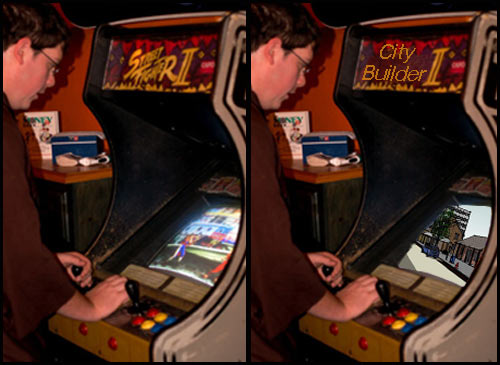The military has recently opened a new type of recruitment office known as "The Army Experience Center" in a Philadelphia shopping mall. It's like an arcade, where video games and other interactive technologies provide visitors a glimpse of what it might be like to be in the military. It's a new approach, one that capitalizes on the modern teenager's affection for video games to attract them to the military life. You could call it persuasive, cajoling, or even a thinly-veiled attempt to con kids with flashy games, but, as it provides exactly what its target audience wants, the bottom line is that it's very effective. Why couldn't a city do the same thing?
The military has recently opened a new type of recruitment office known as "The Army Experience Center" in a Philadelphia shopping mall. It's like an arcade, where video games and other interactive technologies provide visitors a glimpse of what it might be like to be in the military. It's a new approach, one that capitalizes on the modern teenager's affection for video games to attract them to the military life. You could call it persuasive, cajoling, or even a thinly-veiled attempt to con kids with flashy games, but, as it provides exactly what its target audience wants, the bottom line is that it's very effective. Why couldn't a city do the same thing?
It could be like an urban recruitment center, where people could come in and see what's happening in the city, how to get involved, how to make change, and -- maybe most importantly -- how to get a job.

The Army's center is built around technology, using games and software to give a virtual military experience. It's an appropriate approach, as much of the modern-day military is heavily teched-out. Computers are an integral part of much of the military's training and operations. Soldiers even use consumer-grade video games like Halo and Call of Duty to practice shooting and other warfare techniques. The Army even has an official video game to train soldiers for combat.
Like the military, cities are also getting progressively techy. From GIS to computer-aided design to 3D urban design, software is increasingly harnessed by cities and planners to plan, maintain and improve places. Unlike some of the more advanced military tools, most of these technologies are readily available to the general public. Mapping and location-based technologies like Google Maps and Google Earth enable planners and laypeople alike to place themselves in context and in relation to their surroundings. GIS and model building technologies like SketchUp and CAD put the power of spatial design and analysis into the hands of the everyman. Games like SimCity and, more recently, the virtual reality world of Second Life have helped to show that the intricacies of place creation can be a fun and innately creative process.
A recruitment center with these types of games and software stations could be a popular way to engage a general public that might not otherwise think it cares about cities. A fun, interactive place like this could open minds to otherwise underrecognized fields like city planning, urban design, and urban policy.
Imagine walking past the food court in a sterile mall in Anytown, USA and finding a room full of computers, maps, city models, and other people. Not only could more people be exposed to the possibility of working on cities, but planners and other city officials would be able to interact with a public that is not likely to go out of its way to participate in local government in the more traditional (read: boring) way of attending public meetings. Replace a bullet-raining battlefield in Halo with a struggling downtown where players have to decide what to do to bring it back to life. Mixed use? A new Starbucks? A bulldozer? Nobody could really know until they try, and there are numerous available technologies that might be able to make this process actually interesting to video-droned teenagers and laypeople.
By opening up the process in an appealing way, maybe more people, and especially more young people, would be attracted to these fields. At the very least, it would get them thinking about their city the next time they put down the controller and went out into the world.

Planetizen Federal Action Tracker
A weekly monitor of how Trump’s orders and actions are impacting planners and planning in America.

Chicago’s Ghost Rails
Just beneath the surface of the modern city lie the remnants of its expansive early 20th-century streetcar system.

Amtrak Cutting Jobs, Funding to High-Speed Rail
The agency plans to cut 10 percent of its workforce and has confirmed it will not fund new high-speed rail projects.

Ohio Forces Data Centers to Prepay for Power
Utilities are calling on states to hold data center operators responsible for new energy demands to prevent leaving consumers on the hook for their bills.

MARTA CEO Steps Down Amid Citizenship Concerns
MARTA’s board announced Thursday that its chief, who is from Canada, is resigning due to questions about his immigration status.

Silicon Valley ‘Bike Superhighway’ Awarded $14M State Grant
A Caltrans grant brings the 10-mile Central Bikeway project connecting Santa Clara and East San Jose closer to fruition.
Urban Design for Planners 1: Software Tools
This six-course series explores essential urban design concepts using open source software and equips planners with the tools they need to participate fully in the urban design process.
Planning for Universal Design
Learn the tools for implementing Universal Design in planning regulations.
Caltrans
City of Fort Worth
Mpact (founded as Rail~Volution)
City of Camden Redevelopment Agency
City of Astoria
City of Portland
City of Laramie





























